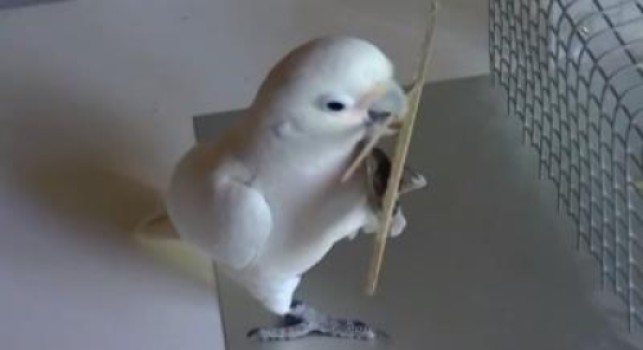We're open daily! View holiday hours
Science News
Cockatoo Smarts
September 4, 2014
by Molly Michelson

We use the term bird-brained to imply someone is “lacking in seriousness or maturity” or “not having or showing an ability to absorb ideas readily,” according to Merriam-Webster. But the more we learn about avian intelligence, the more this definition needs to change.
We’ve covered smart birds often at Science Today (most notably in this video about crows several years ago), but have yet to discuss the mighty cockatoo’s brainpower. But a paper this week in the Proceedings of the Royal Society B exposes these Indonesian parrots for the clever birds they are, at least in captivity.
A few years ago, researchers observed a captive adult male Goffin’s cockatoo named Figaro spontaneously start to sculpt stick tools out of wooden aviary beams to use them for raking in nuts out of his reach. The team wondered if other cockatoos could learn how to do the same, under Figaro’s tutelage.
The scientists set up two separate experiments to find out. One cockatoo group was allowed to observe Figaro employ a ready-made stick tool, while another group of birds witnessed ghost demonstrations with hidden magnets displacing the food. All of the birds were then placed in front of an identical problem, with a ready-made tool lying on the ground nearby.
Figaro’s instruction worked well for the first group. They picked up sticks more than the ghost demo control groups and generally seemed more interested in achieving the result. Remarkably, all three males in this group acquired proficient tool-use, while neither the females in the same group nor males and females in the ghost demo groups did.
The successful birds didn’t just imitate Figaro’s movements: they made them their own! Figaro held tools by their tips, inserted them through the cage grid at different heights, and raked the nuts towards him while adjusting the tool’s position as the target moved closer. The student cockatoos laid the sticks on the ground and propelled the nuts into their reach by a quick ballistic flipping movement, employing a more efficient maneuver than their teacher used.
“This means that although watching Figaro was necessary for their success they did not imitate his exact motor activities. Successful observers seemed to attend to the result of Figaro’s interaction with the tool but developed their own strategies for reaching the same result, rather than copying his actions. This is typical of what psychologists would call emulation learning,” explains lead author Alice Auersperg, of the University of Vienna.
Co-author Alex Kacelnik (who was also part of the crow study in the aforementioned video) concurs. “There is a substantial difference between repeating a teacher’s behavior and emulating his or her achievements while creating one’s own methods. The latter implies a creative process stimulated by a social interaction, while the former could, at least potentially, rely on simpler imitation. The cockatoos seem to emulate and surpass their teacher, which is what all good professors hope for from their best students.”
In a later experiment, two of the cockatoos were even able to fashion their own tools. A video of the tool-making is available here.
The cockatoos demonstrated creativity, constructiveness, and intelligence—providing new definitions for bird-brained. Let’s just hope it catches on.
Image: Alice Auersperg